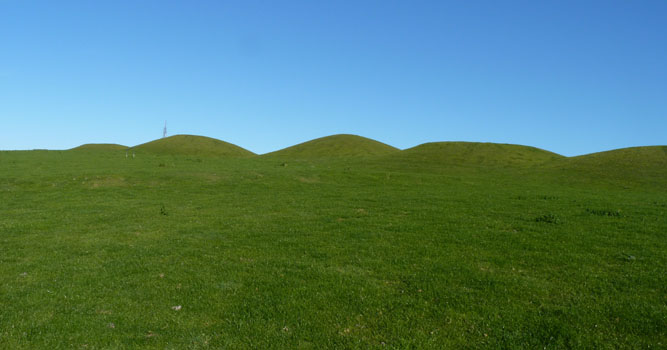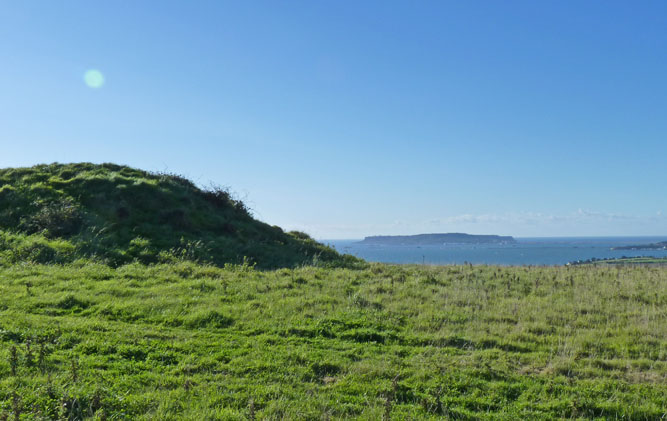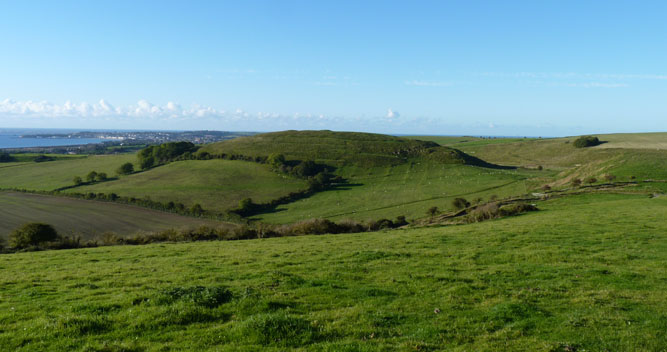Sutton Poyntz sits in a hugely important area of Neolithic and Bronze Age human occupation, the Dorset Ridgeway. The hills to the north of Sutton Poyntz have a number of round barrows, built around 4000 years ago, probably as burial sites. There is also one bank barrow and one long barrow that are rather older; the bank barrow may have been a boundary marker.
To the west of Sutton Poyntz, Chalbury Hill is one of the first hillforts in the area, built around 800BC (the visible fortifications of the nearby Maiden Castle are about 400 years later). Immediately to the south of Chalbury Hill is Rimbury, where evidence of a 3500 year old burial ground was found, one of the two type-sites of what has been termed the Deverel-Rimbury culture.
The things we see from these ages are just those things that last, and say little about real life then. Nevertheless, it seems reasonable to assume that life was lived then mainly up on the downs; at least early in this period, the valley that now contains the village and surrounding farm-land would have been forested and relatively inaccessible.
|
Bincombe Bumps, a cluster of round barrows |
Barrows
Sutton Poyntz sits just below the Dorset Ridgeway, near its eastern end. The Ridgeway is a line of hill escarpment running more or less east-west, close to the Dorset coast, and is one of the richest areas for ancient barrows and larger earthworks, evidence of a sophisticated and economically stable population from the Neolithic age through to the birth of the Iron Age. The earthworks along the Dorset Ridgeway cover a period of over 2000 years, culminating with the nearby Maiden Castle in the late pre-Roman era, and including three main periods:
- Long barrows and bank barrows, built in the Neolithic era between about 3200BC and 2600BC;
- Round barrows of various types, built mainly in the Bronze Age between about 2600BC and 1600BC;
- Hillforts, built after about 800BC.
|
Round barrow directly above Sutton Poyntz |
The hills immediately above Sutton Poyntz have a significant cluster of round barrows of several types, including ditched, bowl and pond barrows. One long barrow has been found, on Chalbury Hill but predating the hill fortifications by maybe two millennia. There is also one bank barrow at the crest of the hill, surrounded by yet another cluster of round barrows. The round barrows and long barrows were generally used for burials; the bank barrow's purpose is not clear, but may have been as a boundary marker. These earthworks are clear evidence of significant social units living in the area.
Chalbury Hillfort
|
Chalbury Hillfort, seen from above Sutton Poyntz |
Immediately to the west of Sutton Poyntz, an isolated hill stands as an outcrop of the Ridgeway. This is Chalbury hill, where one of the first hillforts in the area was built, in about 800BC. This hillfort predates the visible fortifications of Maiden Castle, although the eastern end of Maiden Castle had been protected by much older ditches.
Deverel-Rimbury
Not all the evidence of prehistoric occupation in the area is so obvious. Some time in the first half of the 19th Century, the farmers at the main farm in Sutton Poyntz sent some workers out to an area called Rimbury, to clear the fields for ploughing. Rimbury is a hill spur on the south-east corner of Chalbury, and had until then been used as sheep down, so had never been ploughed. As the workers cleared the stones from the ridge, they found that many of the stones covered chambers, each with a pot inside. They knew that another worker had once uncovered a hoard of Roman coins while ploughing a Sutton Poyntz field, so it is easy to imagine their excitement and anticipation, quickly dashed when it proved that the pots contained nothing other than bones and ash. In their frustration, they lined the pots up in the field, and used them for stone-throwing target practice, until the farmer (whose name is not given but was possibly one of the Scutt brothers) stopped them. A team of 'antiquarians' (as archaeologists were then known) came in to investigate, led by Charles Warne who later wrote up the excavation in his book "Celtic Tumuli of Dorset" - frustratingly, Mr Warne did not give a date for the excavation.
The "antiquarians" described what then was a newly discovered type of pottery, and a novel form of funeral using cremation, which is now known to date from about 1600-1100BC. In 1912, Lord Abercromby, in "The Bronze Age Pottery of Great Britain and Ireland", combined the results from this excavation at Rimbury with those of another excavation, at a tumulus called Deverel mid way between Milborne St Andrew and Winterborne Whitchurch (excavated in 1825 by W A Miles). Lord Abercromby named this culture Deverel-Rimbury; he dated it (erroneously) to about 700BC, and stated his belief (again erroneous) that it represented evidence of a local invasion from continental Europe.
Modern scholarship has demoted the significance of Deverel-Rimbury, which is now generally only used to describe the pottery type, since it is not thought to represent a distinct culture. Nevertheless, the term is still in quite common use.



